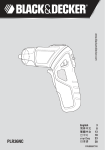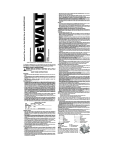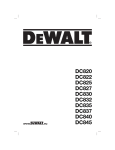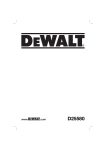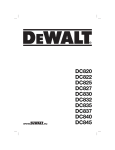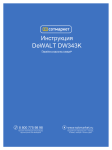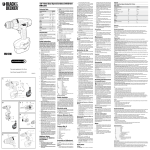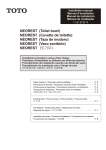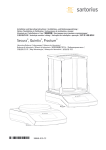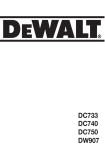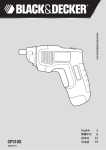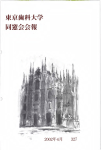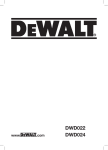Download DeWalt DC820 Technical data
Transcript
www. .com DC820 DC822 DC825 DC827 DC830 DC832 DC835 DC837 DC840 DC845 Figure 1 c d g B A h i Figure 2 i h j Figure 3 A B 1 Figure 4 d c Figure 5 f e 2 E NG L I S H DC820, DC822, DC825, DC827, DC830, DC832, DC835, DC837, DC840, DC845 CORDLESS IMPACT WRENCHES/DRIVERS Congratulations! You have chosen a DEWALT tool. Years of experience, thorough product development and innovation make DEWALT one of the most reliable partners for professional power tool users. Technical data Voltage Battery Type VDC No-load speed Impact Max. torque Tool holder min-1 min-1 Nm Max. bolt size Weight (without battery pack) mm DC820 18 NiCd/NiMH – 0-2400 2700 195 1/2" Square M16 kg 0.98 Battery pack Battery type Voltage Capacity Weight VDC Ah kg Charger Mains voltage Battery type Approx. charging time min Weight kg Fuses: Europe U.K. & Ireland DC822 DC825 DC827 DC830 DC832 DC835 DC837 DC840 DC845 18 18 18 14.4 14.4 14.4 14.4 12 12 – NiCd/NiMH – NiCd/NiMH – NiCd/NiMH – NiCd/NiMH NiCd/NiMH Li-Ion – Li-Ion – Li-Ion – Li-Ion – – 0-2400 0-2400 0-2400 0-2400 0-2400 0-2400 0-2400 0-2400 0-2400 2700 2700 2700 2700 2700 2700 2700 2700 2700 195 150 150 180 180 140 140 160 130 1/2" 1/4" 1/4" 1/2" 1/2" 1/4" 1/4" 1/2" 1/4" Square Hex Hex Square Square Hex Hex Square Hex M16 M12 M12 M16 M16 M12 M12 M16 M12 VAC 230 V tools 230 V tools 0.96 0.98 DE9180 Li-Ion 18 2.0 0.68 0.96 0.96 DE9503 NiMH 18 2.6 1.0 DE9130 230 NiCd/NiMH 30 (2.0 Ah battery packs) 0.52 0.96 DE9140 Li-Ion 14.4 2.0 0.58 0.96 0.96 DE9502 NiMH 14.4 2.6 0.86 0.96 0.96 DE9501 NiMH 12 2.6 0.69 DE9135 230 NiCd/NiMH/Li-Ion 40 (2.0 Ah battery packs) 0.52 10 Amperes, mains 13 Amperes, in plugs 28 3 EN GLI S H Definitions: Safety Guidelines CAUTION: Indicates a potentially hazardous situation which, if not avoided, may result in minor or moderate injury. CAUTION: Used without the safety alert symbol indicates a potentially hazardous situation which, if not avoided, may result in property damage. The definitions below describe the level of severity for each signal word. Please read the manual and pay attention to these symbols. DANGER: Indicates an imminently hazardous situation which, if not avoided, will result in death or serious injury. WARNING: Indicates a potentially hazardous situation which, if not avoided, could result in death or serious injury. LpA (sound pressure) KpA (sound pressure uncertainty K) LWA (acoustic power) KWA (acoustic power uncertainty K) Denotes risk of electric shock. Denotes risk of fire. dB(A DC820 91 DC822 91 DC825 90 DC827 DC830 DC832 DC835 DC837 DC840 DC845 90 91 91 90 90 91 90 dB(A) dB(A) 3 102 3 102 3 101 3 101 3 102 3 102 3 101 3 101 3 102 3 101 dB(A) 3 3 3 3 3 3 3 3 3 3 9.7 2.3 9.7 2.3 13.7 5.3 13.7 5.3 9.7 2.3 13.7 5.3 Vibration total values (triax vector sum) determined according to EN60745: Vibration emission value m/s² 9.7 9.7 13.7 13.7 Uncertainty K m/s² 2.3 2.3 5.3 5.3 The declared vibration emission value has been measured in accordance with a standard test method and may be used for comparing one tool with another. EC-Declaration of conformity The declared vibration emission value may also be used in a preliminary assessment of exposure. DC820, DC822, DC825, DC827, DC830, DC832, DC835, DC837, DC840, DC845 DEWALT declares that these tools have been designed in compliance with: 98/37/EC, 89/336/EEC, 2006/95/EC, EN 60745-1, EN 60745-2-2, EN 55014-2, EN 55014-1. WARNING: The vibration emission value during actual use of the power tool can differ from the declared value depending on the ways in which the tool is used. This could lead to a significant underestimate of exposure when the tool is used regularly in such a way. An estimation of the level of exposure to vibration experienced during a given period of work should also take into account the times when the tool is switched off and when it is running idle in addition to the trigger time. This may significantly reduce the exposure level over the total working period. 4 29 For more information, please contact DEWALT at the address below, or refer to the back of the manual. Director Engineering and Product Development Horst Grossmann DEWALT, Richard-Klinger-Strase 11, D-65510, Idstein, Germany 16/08/2007 ENGLISH WARNING: To reduce the risk of injury, read the instruction manual. General Power Tool Safety Warnings WARNING! Read all safety warnings and instructions Failure to follow the warnings and instructions may result in electric shock, fire and/or serious injury. SAVE ALL WARNINGS AND INSTRUCTIONS FOR FUTURE REFERENCE. The term “power tool" in the warnings refers to your mains-operated (corded) power tool or batteryoperated (cordless) power tool. 1) WORK AREA SAFETY a) Keep work area clean and well lit. Cluttered or dark areas invite accidents. b) Do not operate power tools in explosive atmospheres, such as in the presence of flammable liquids, gases or dust. Power tools create sparks which may ignite the dust or fumes. c) Keep children and bystanders away while operating a power tool. Distractions can cause you to lose control. 2) ELECTRICAL SAFETY a) Power tool plugs must match the outlet. Never modify the plug in any way. Do not use any adapter plugs with earthed (grounded) power tools. Unmodified plugs and matching outlets will reduce risk of electric shock. b) Avoid body contact with earthed or grounded surfaces such as pipes, radiators, ranges and refrigerators. There is an increased risk of electric shock if your body is earthed or grounded. c) Do not expose power tools to rain or wet conditions. Water entering a power tool will increase the risk of electric shock. d) Do not abuse the cord. Never use the cord for carrying, pulling or unplugging the power tool. Keep cord away from heat, oil, sharp edges or moving parts. Damaged or entangled cords increase the risk of electric shock. e) When operating a power tool outdoors, use an extension cord suitable for outdoor use. Use of a cord suitable for outdoor use reduces the risk of electric shock. f) If operating a power tool in a damp location is unavoidable, use a residual current device (RCD) protected supply. Use of an RCD reduces the risk of electric shock. 3) PERSONAL SAFETY a) Stay alert, watch what you are doing and use common sense when operating a power tool. Do not use a power tool while you are tired or under the influence of drugs, alcohol or medication. A moment of inattention while operating power tools may result in serious personal injury. b) Use personal protective equipment. Always wear eye protection. Protective equipment such as dust mask, non-skid safety shoes, hard hat, or hearing protection used for appropriate conditions will reduce personal injuries. c) Prevent unintentional starting. Ensure the switch is in the off position before connecting to power source and/or battery pack, picking up or carrying the tool. Carrying power tools with your finger on the switch or energising power tools that have the switch on invites accidents. d) Remove any adjusting key or wrench before turning the power tool on. A wrench or a key left attached to a rotating part of the power tool may result in personal injury. e) Do not overreach. Keep proper footing and balance at all times. This enables better control of the power tool in unexpected situations. f) Dress properly. Do not wear loose clothing or jewellery. Keep your hair, clothing and gloves away from moving parts. Loose clothes, jewellery or long hair can be caught in moving parts. g) If devices are provided for the connection of dust extraction and collection facilities, ensure these are connected and properly used. Use of dust collection can reduce dust-related hazards. 4) POWER TOOL USE AND CARE a) Do not force the power tool. Use the correct power tool for your application. The correct power tool will do the job better and safer at the rate for which it was designed. b) Do not use the power tool if the switch does not turn it on and off. Any power tool that cannot be controlled with the switch is dangerous and must be repaired. c) Disconnect the plug from the power source and/or the battery pack from the power tool before making any adjustments, changing accessories, or storing power tools. Such preventive safety 30 5 EN GLI S H d) e) f) g) measures reduce the risk of starting the power tool accidentally. Store idle power tools out of the reach of children and do not allow persons unfamiliar with the power tool or these instructions to operate the power tool. Power tools are dangerous in the hands of untrained users. Maintain power tools. Check for misalignment or binding of moving parts, breakage of parts and any other condition that may affect the power tool’s operation. If damaged, have the power tool repaired before use. Many accidents are caused by poorly maintained power tools. Keep cutting tools sharp and clean. Properly maintained cutting tools with sharp cutting edges are less likely to bind and are easier to control. Use the power tool, accessories and tool bits etc., in accordance with these instructions taking into account the working conditions and the work to be performed. Use of the power tool for operations different from those intended could result in a hazardous situation. 5) BATTERY TOOL USE AND CARE a) Recharge only with the charger specified by the manufacturer. A charger that is suitable for one type of battery pack may create a risk of fire when used with another battery pack. b) Use power tools only with specifically designated battery packs. Use of any other battery packs may create a risk of injury and fire. c) When battery pack is not in use, keep it away from other metal objects like paper clips, coins, keys, nails, screws or other small metal objects that can make a connection from one terminal to another. Shorting the battery terminals together may cause burns or a fire. d) Under abusive conditions, liquid may be ejected from the battery, avoid contact. If contact accidentally occurs, flush with water. If liquid contacts eyes, additionally seek medical help. Liquid ejected from the battery may cause irritation or burns. 6) SERVICE a) Have your power tool serviced by a qualified repair person using only identical replacement parts. This will ensure that the safety of the power tool is maintained. 6 31 ADDITIONAL SPECIFIC SAFETY RULES Safety Instructions for All Impact Drills • Wear ear protectors with impact drills. Exposure to noise can cause hearing loss. • Use auxiliary handles supplied with the tool. Loss of control can cause personal injury. • Hold power tools by insulated gripping surfaces when performing an operation where the cutting tool may contact hidden wiring or its own cord. Contact with a “live" wire will make exposed metal parts of the tool “live" and shock the operator. • Use clamps or other practical way to secure and support the workpiece to a stable platform. Holding the work by hand or against your body is unstable and may lead to loss of control. • Wear safety goggles or other eye protection. Hammering and drilling operations cause chips to fly. Flying particles can cause permanent eye damage. • Bits, sockets and tools get hot during operation. Wear gloves when touching them. • Do not operate this tool for long periods of time. Vibration caused by tool action may be harmful to your hands and arms. Use gloves to provide extra cushion and limit exposure by taking frequent rest periods. Residual risks In spite of the application of the relevant safety regulations and the implementation of safety devices, certain residual risks cannot be avoided. These are: – Impairment of hearing – Risk of personal injury due flying particles. – Risk of burns due to accessories becoming hot during operation. – Risk of personal injury due to prolonged use. Labels on tool The following pictograms are shown on the tool: Wear ear protection. Wear eye protection. ENGLISH DATE CODE POSITION • Do not expose charger to rain or snow. Date Code, which also includes the year of manufacture, is printed into the housing surface that forms the mounting joint between tool and battery! • Pull by plug rather than cord when disconnecting charger. This will reduce risk of damage to electric plug and cord. Example: • Make sure that cord is located so that it will not be stepped on, tripped over, or otherwise subjected to damage or stress. 2007 XX XX Year of Manufacture Important Safety Instructions for All Battery Chargers SAVE THESE INSTRUCTIONS: This manual contains important safety and operating instructions for the DE9130/DE9135 battery chargers. • Before using charger, read all instructions and cautionary markings on charger, battery pack, and product using battery pack. DANGER: Electrocution hazard. 230 volts are present at charging terminals. Do not probe with conductive objects. Electric shock or electrocution may result. WARNING: Shock hazard. Do not allow any liquid to get inside charger. Electric shock may result. CAUTION: Burn hazard. To reduce the risk of injury, charge only DEWALT rechargeable batteries. Other types of batteries may burst causing personal injury and damage. CAUTION: Under certain conditions, with the charger plugged in to the power supply, the exposed charging contacts inside the charger can be shorted by foreign material. Foreign materials of a conductive nature such as, but not limited to, steel wool, aluminum foil, or any buildup of metallic particles should be kept away from charger cavities. Always unplug the charger from the power supply when there is no battery pack in the cavity. Unplug charger before attempting to clean. • DO NOT attempt to charge the battery pack with any chargers other than the ones in this manual. The charger and battery pack are specifically designed to work together. • These chargers are not intended for any uses other than charging DEWALT rechargeable batteries. Any other uses may result in risk of fire, electric shock or electrocution. • Do not use an extension cord unless it is absolutely necessary. Use of improper extension cord could result in risk of fire, electric shock, or electrocution. • An extension cord must have adequate wire size (AWG or American Wire Gauge) for safety. The smaller the gauge number of the wire, the greater the capacity of the cable, that is 16 gauge has more capacity than 18 gauge. When using more than one extension to make up the total length, be sure each individual extension contains at least the minimum wire size. • Do not place any object on top of charger or place the charger on a soft surface that might block the ventilation slots and result in excessive internal heat. Place the charger in a position away from any heat source. The charger is ventilated through slots in the top and the bottom of the housing. • Do not operate charger with damaged cord or plug — have them replaced immediately. • Do not operate charger if it has received a sharp blow, been dropped, or otherwise damaged in any way. Take it to an authorized service center. • Do not disassemble charger; take it to an authorized service center when service or repair is required. Incorrect reassembly may result in a risk of electric shock, electrocution or fire. • Disconnect the charger from the outlet before attempting any cleaning. This will reduce the risk of electric shock. Removing the battery pack will not reduce this risk. • NEVER attempt to connect 2 chargers together. • The charger is designed to operate on standard 230V household electrical power. Do not attempt to use it on any other voltage. This does not apply to the vehicular charger. SAVE THESE INSTRUCTIONS 32 7 E N GLI S H Chargers The DE9130 charger accepts 7.2 – 18 V NiCd and NiMH batteries. then automatically switches to the pack charging mode. This feature ensures maximum battery life. DEEP DISCHARGE PROTECTION The DE9135 charger accepts 7.2 – 18 V NiCd, NiMH or Li-Ion batteries. The battery pack is protected against deep discharging when it is used in the tool. These chargers require no adjustment and are designed to be as easy as possible to operate. Important Safety Instructions for All Battery Packs Charging Procedure DANGER: Electrocution hazard. 230 volts present at charging terminals. Do not probe with conductive objects. Danger of electric shock or electrocution. 1. Plug the charger (j) into an appropriate outlet before inserting battery pack. 2. Insert the battery pack (h) into the charger. The red (charging) light will blink continuously indicating that the charging process has started. 3. The completion of charge will be indicated by the red light remaining ON continuously. The pack is fully charged and may be used at this time or left in the charger. Charging process Refer the table below for the state of charge of the battery pack. State of charge charging fully charged hot/cold pack delay replace battery pack problem – – – – – – ––––––––––– ––– – ––– – ••••••••••• •• •• •• •• Automatic refresh The automatic refresh mode will equalise or balance the individual cells in the battery pack at its peak capacity. Battery packs should be refreshed weekly or whenever the pack no longer delivers the same amount of work. To refresh your battery pack, place the battery in the charger as usual. Leave the battery pack for at least 8 hours in the charger. Hot/Cold Pack Delay When the charger detects a battery that is too hot or too cold, it automatically starts a Hot/Cold Pack Delay, suspending charging until the battery has reached an appropriate temperature. The charger 8 33 When ordering replacement battery packs, be sure to include catalog number and voltage. Consult the chart at the end of this manual for compatibility of chargers and battery packs. The battery pack is not fully charged out of the carton. Before using the battery pack and charger, read the safety instructions below. Then follow charging procedures outlined. READ ALL INSTRUCTIONS • Do not charge or use battery in explosive atmospheres, such as in the presence of flammable liquids, gases or dust. Inserting or removing the battery from the charger may ignite the dust or fumes. • Charge the battery packs only in DEWALT chargers. • DO NOT splash or immerse in water or other liquids. • Do not store or use the tool and battery pack in locations where the temperature may reach or exceed 40˚ C (105° F) (such as outside sheds or metal buildings in summer). DANGER: Electrocution hazard. Never attempt to open the battery pack for any reason. If battery pack case is cracked or damaged, do not insert into charger. Electric shock or electrocution may result. Damaged battery packs should be returned to service center for recycling. WARNING: Never attempt to open the battery pack for any reason. If battery pack case is cracked or damaged, do not insert into charger. Do not crush, drop or damage battery pack. Do not use a battery pack or charger that has received a sharp blow, been dropped, run over or damaged in any way (i.e., pierced with a nail, hit with a hammer, stepped on). Damaged battery packs should be returned to service center for recycling. E NG L I S H CAUTION: When not in use, place tool on its side on a stable surface where it will not cause a tripping or falling hazard. Some tools with large battery packs will stand upright on the battery pack but may be easily knocked over. SPECIFIC SAFETY INSTRUCTIONS FOR NICKEL CADMIUM (NiCd) OR NICKEL METAL HYDRIDE (NiMH) • Do not incinerate the battery pack even if it is severely damaged or is completely worn out. The battery pack can explode in a fire. • A small leakage of liquid from the battery pack cells may occur under extreme usage or temperature conditions. This does not indicate a failure. However, if the outer seal is broken: a. and the battery liquid gets on your skin, immediately wash with soap and water for several minutes. b. and the battery liquid gets into your eyes, flush them with clean water for a minimum of 10 minutes and seek immediate medical attention. (Medical note: The liquid is 25-35% solution of potassium hydroxide.) SPECIFIC SAFETY INSTRUCTIONS FOR LITHIUM ION (LI-ION) • Do not incinerate the battery pack even if it is severely damaged or is completely worn out. The battery pack can explode in a fire. Toxic fumes and materials are created when lithium ion battery packs are burned. • If battery contents come into contact with the skin, immediately wash area with mild soap and water. If battery liquid gets into the eye, rinse water over the open eye for 15 minutes or until irritation ceases. If medical attention is needed, the battery electrolyte is composed of a mixture of liquid organic carbonates and lithium salts. • Contents of opened battery cells may cause respiratory irritation. Provide fresh air. If symptoms persists, seek medical attention. WARNING: Burn hazard. Battery liquid may be flammable if exposed to spark or flame. Battery Cap (fig. 3) A protective battery cap is supplied to cover the contacts of a detached battery pack. Without the protective cap in place, loose metal objects could short circuit the contacts, causing a fire hazard and damaging the battery pack. 1. Take off the protective battery cap before placing the battery pack in the charger or tool (Fig. 3A). 2. Place the protective cap over the contacts immediately after removing the battery pack from the charger or tool (Fig. 3B). WARNING: Make sure the protective battery cap is in place before storing or carrying a detached battery pack. Battery pack (fig. 1) BATTERY TYPE The DC820, DC822, DC825 and DC827 operate on 18 volt battery packs. The DC830, DC832, DC835 and DC837 operate on 14.4 volt battery packs. The DC840 and DC845 operate on 12 volt battery packs. Storage Recommendations 1. The best storage place is one that is cool and dry away from direct sunlight and excess heat or cold. 2. Long storage will not harm the battery pack or charger. Under proper conditions, they can be stored for 5 years or more. Labels on charger and battery pack In addition to the pictographs used in this manual, the labels on the charger and the battery pack show the following pictographs: Read instruction manual before use. Battery charging. Battery charged. Battery defective. Hot/cold pack delay. Do not probe with conductive objects. Do not charge damaged battery packs. 34 9 E N GLI S H Use only with DEWALT battery packs, others may burst, causing personal injury and damage. Do not expose to water. Have defective cords replaced immediately. The impact function makes this tool particularly useful for driving fasteners in wood, metal and concrete. DO NOT use under wet conditions or in presence of flammable liquids or gases. These impact wrenches/drivers are professional power tools. DO NOT let children come into contact with the tool. Supervision is required when inexperienced operators use this tool. a. Trigger switch Charge only between 4 °C and 40 °C. b. Forward/reverse button Discard the battery pack with due care for the environment. d. 1/4" hex quick-release chuck c. Sleeve e. Detent pin Do not incinerate the battery pack NiMH, NiCd+ and Li-Ion. f. Anvil g. Worklight h. Battery pack Charges NiMH and NiCd battery packs. i. Battery release buttons Electrical safety Charges Li-Ion battery packs. See technical data for charging time. Package contents The package contains: 1 Cordless Impact Driver/Wrench 2 Battery packs 1 Charger 1 Instruction manual 1 Exploded drawing NOTE: Battery packs and chargers are not included with N-models. • Check for damage to the tool, parts or accessories which may have occurred during transport. • Take the time to thoroughly read and understand this manual prior to operation. Description (fig. 1–5) WARNING: Never modify the power tool or any part of it. Damage or personal injury could result. INTENDED USE These heavy-duty impact wrenches/drivers are designed for professional impact screwdriving applications. 10 35 The electric motor has been designed for one voltage only. Always check that the battery pack voltage corresponds to the voltage on the rating plate. Also make sure that the voltage of your charger corresponds to that of your mains. Your DEWALT charger is double insulated in accordance with EN 60335; therefore no earth wire is required. If the supply cord is damaged, it must be replaced by a specially prepared cord available through the DEWALT service organization. Mains plug replacement (U.K. & Ireland only) DANGER: • Should your mains plug need replacing and you are competent to do this, proceed as instructed below. If you are in doubt, contact an authorized DEWALT repair agent or a qualified electrician. • Disconnect the plug from the supply. • Cut off the plug and dispose of it safely; a plug with bared copper conductors is dangerous if engaged in a live socket outlet. • Only fit 13 Amperes BS1363A approved plugs fitted with the correctly rated fuse (1). E NG L I S H • The cable wire colours, or a letter, will be marked at the connection points of most good quality plugs. Attach the wires to their respective points in the plug (see below). Brown is for Live (L) (2) and Blue is for Neutral (N) (4). • Before replacing the top cover of the mains plug ensure that the cable restraint (3) is holding the outer sheath of the cable firmly and that the two leads are correctly fixed at the terminals crews. TO INSTALL THE BATTERY PACK INTO THE TOOL HANDLE 1. Align the base of the tool with the notch inside the tool’s handle (Fig. 2). 2. Slide the battery pack firmly into the handle until you hear the lock snap into place. TO REMOVE THE BATTERY PACK FROM THE TOOL 1. Press the battery release buttons (i) and firmly pull the battery pack out of the tool handle. 2. Insert battery pack into the charger as described in the charger section of this manual. 1 2 4 OPERATION Instructions for use WARNING: Always observe the safety instructions and applicable regulations. 3 Variable Speed Trigger Switch (fig. 1) To turn the tool on, squeeze the trigger switch (a). WARNING: NEVER use a light socket. To turn the tool off, release the trigger switch. NEVER connect the live (L) or neutral (N) wires to the earth pin marked E or . Your tool is equipped with a brake. The chuck will stop as soon as the trigger switch is fully released. Using an extension cable An extension cord should not be used unless absolutely necessary. Use an approved extension cable suitable for the power input of your charger (see technical data). The minimum conductor size is 1 mm2; the maximum length is 30 m. Use lower speeds for starting holes without a center punch, drilling in metals or plastics, or driving screws. For maximum tool life, use variable speed only for starting holes or fasteners. NOTE: Continuous use in variable speed range is not recommended. It may damage the switch and should be avoided. When using a cable reel, always unwind the cable completely. Forward/Reverse Control Button (fig. 1) ASSEMBLY AND ADJUSTMENTS A forward/reverse control button (b) determines the direction of the tool and also serves as a lock off button. WARNING: Prior to assembly and adjustment, always remove the battery pack. Always switch off the tool before inserting or removing the battery pack. WARNING: Use only DEWALT battery packs and chargers. Inserting and removing the battery pack from the tool (fig. 2) WARNING: To reduce the risk of serious personal injury, turn tool off and disconnect battery pack before making any adjustments or removing/ installing attachments or accessories. An accidental start-up can cause injury. To select forward rotation, release the trigger switch and depress the forward/reverse control button on the right side of the tool. To select reverse, depress the forward/reverse control button on the left side of the tool. The center position of the control button locks the tool in the OFF position. When changing the position of the control button, be sure the trigger is released. NOTE: The first time the tool is run after changing the direction of rotation, you may hear a click on start up. This is normal and does not indicate a problem. 36 11 EN GLI S H Worklight (fig. 1) There is a worklight (g) located just above the trigger switch (a). The worklight will be activated when the trigger switch is squeezed. NOTE: The worklight is for lighting the immediate work surface and is not intended to be used as a flashlight. Quick-Release Chuck (fig. 4) DC825, DC827, DC835, DC837, DC845 Cat # DC835 DC837 Ft.-Lbs. 103 103 In.-Lbs. 1240 1240 Nm 140 140 DC840 120 1440 160 DC845 96 1150 130 CAUTION: Ensure fastener and/or system will withstand the level of torque generated by the tool. Excessive torque may cause breakage and possible personal injury. NOTE: The chuck accepts 1/4" hex accessories only. 1. Place the socket on the fastener head. Keep the tool pointed straight at the fastener. Place the switch in the locked off (center) position or remove battery pack before changing accessories. 2. Press switch to start operation. Always check torque with a torque wrench, as the fastening torque is affected by many factors including the following: To install an accessory, pull the chuck collar (c) away from the front of the tool, insert the accessory and release the collar. The accessory is locked in place. To remove an accessory, pull the chuck collar away from the front of the tool. Remove the accessory and release the collar. Anvil With Detent Pin (fig. 5) DC820, DC822, DC830, DC832, DC840 Place the switch in the locked off (center) position or remove battery pack before changing accessories. To install a socket on the anvil, align the hole in the side of the socket with the detent pin (e) on the anvil (f). Press the socket on until the detent pin engages in the hole. Depression of detent pin may be necessary to aid installation of socket. CAUTION: Use only impact sockets. Non-impact sockets may break and cause a hazardous condition. Inspect socket prior to use to ensure that it contains no cracks. To remove a socket, depress the detent pin through the hole and pull the socket off. Usage Your impact tool generates the following output torque: 12 Cat # Ft.-Lbs. In.-Lbs. Nm DC820 DC822 DC825 DC827 DC830 DC832 145 145 111 111 135 135 1740 1740 1330 1330 1620 1620 195 195 150 150 180 180 37 • Voltage: Low voltage, due to a nearly discharged battery, will reduce fastening torque. • Socket size: Failure to use the correct socket size will cause a reduction in fastening torque. • Bolt Size: Larger bolt diameters generally require higher fastening torque. Fastening torque will also vary according to length, grade, and torque coefficient. • Bolt: Ensure that all threads are free of rust and other debris to allow proper fastening torque • Material: The type of material and surface finish of the material will affect fastening torque. • Fastening Time: Longer fastening time results in increased fastening torque. Using a longer fastening time than recommended could cause the fasteners to be overstressed, stripped or damaged. MAINTENANCE Your DEWALT power tool has been designed to operate over a long period of time with a minimum of maintenance. Continuous satisfactory operation depends upon proper tool care and regular cleaning. WARNING: To reduce the risk of serious personal injury, turn tool off and disconnect battery pack before making any adjustments or removing/ installing attachments or accessories. An accidental start-up can cause injury. E NG L I S H Lubrication Your power tool requires no additional lubrication. Cleaning WARNING: Blow dirt and dust out of the main housing with dry air as often as dirt is seen collecting in and around the air vents. Wear approved eye protection and approved dust mask when performing this procedure. WARNING: Never use solvents or other harsh chemicals for cleaning the non-metallic parts of the tool. These chemicals may weaken the materials used in these parts. Use a cloth dampened only with water and mild soap. Never let any liquid get inside the tool; never immerse any part of the tool into a liquid. CHARGER CLEANING INSTRUCTIONS WARNING: Shock hazard. Disconnect the charger from the AC outlet before cleaning. Dirt and grease may be removed from the exterior of the charger using a cloth or soft non-metallic brush. Do not use water or any cleaning solutions. Optional accessories WARNING: Since accessories, other than those offered by DEWALT, have not been tested with this product, use of such accessories with this tool could be hazardous. To reduce the risk of injury, only DEWALT, recommended accessories should be used with this product. Should you find one day that your DEWALT product needs replacement, or if it is of no further use to you, do not dispose of it with household waste. Make this product available for separate collection. Separate collection of used products and packaging allows materials to be recycled and used again. Re-use of recycled materials helps prevent environmental pollution and reduces the demand for raw materials. Local regulations may provide for separate collection of electrical products from the household, at municipal waste sites or by the retailer when you purchase a new product. DEWALT provides a facility for the collection and recycling of DEWALT products once they have reached the end of their working life. To take advantage of this service please return your product to any authorised repair agent who will collect them on our behalf. You can check the location of your nearest authorised repair agent by contacting your local DEWALT office at the address indicated in this manual. Alternatively, a list of authorised DEWALT repair agents and full details of our after-sales service and contacts are available on the Internet at: www.2helpU.com. Rechargeable Battery Pack This long life battery pack must be recharged when it fails to produce sufficient power on jobs which were easily done before. At the end of its technical life, discard it with due care for our environment: • Run the battery pack down completely, then remove it from the tool. • Li-Ion, NiCd and NiMH cells are recyclable. Take them to your dealer or a local recycling station. The collected battery packs will be recycled or disposed of properly. Consult your dealer for further information on the appropriate accessories. Protecting the environment Separate collection. This product must not be disposed of with normal household waste. 38 13 Ⱥը ,+ ,+ ,+ ,+ ,+ ,+ ,+ ,+ ,+ ,+ Ӻؚ০ৃюࣺμШޭՅ ࣛੂੈ͈͒ ,-?)4<લૐ໓ሳጄຫጁఁఋ,-?)4<௴೯ઠጔ႞ዜ੭෧ෟጡཅၕቛጄ ႖බ႖લૐຫဧၴ౹ၦၨႜዻ௴ૺ࿕ၒചၴ൘ၼྤတཀఁఋ Ɂ٣ͼޭ 전압 배터리 종류 V DC 무부하 속도 임팩트 최대 토크 공구 홀더 min-1 min-1 Nm 최대 볼트 크기 mm 중량 (배터리 팩 제외) kg 배터리 팩 배터리 종류 전압 용량 중량 충전기 주 전압 배터리 종류 대략적 충전 시간 중량 퓨즈: 유럽 영국 및 아일랜드 14 DC820 DC822 DC825 18 18 18 NiCd/NiMH NiCd/NiMH Li-Ion 0-2400 0-2400 0-2400 2700 2700 2700 195 195 150 1/2" 1/2" 1/4" 사각 사각 육각 M16 M16 M12 0.98 0.96 V DC Ah kg V AC 분 kg DC827 DC830 DC832 DC835 DC837 DC840 DC845 18 14.4 14.4 14.4 14.4 12 12 NiCd/NiMH NiCd/NiMH NiCd/NiMH NiCd/NiMH Li-Ion Li-Ion Li-Ion 0-2400 0-2400 0- 2400 0-2400 0-2400 0-2400 0-2400 2700 2700 2700 2700 2700 2700 2700 150 180 180 140 140 160 130 1/4" 1/2" 1/2" 1/4" 1/4" 1/2" 1/4" 육각 사각 사각 육각 육각 사각 육각 M12 M16 M16 M12 M12 M16 M12 0.98 DE9180 Li-Ion 18 2.0 0.68 0.96 0.96 DE9503 NiMH 18 2.6 1.0 DE9130 230 NiCd/NiMH 30 (2.0 Ah 배터리 팩) 0.52 230 V 공구 10 A, 주 전압 230 V 공구 13 A, 플러그 0.96 DE9140 Li-Ion 14.4 2.0 0.58 0.96 0.96 DE9502 NiMH 14.4 2.6 0.86 DE9135 230 NiCd/NiMH/Li-Ion 40 (2.0 Ah 배터리 팩) 0.52 0.96 0.96 DE9501 NiMH 12 2.6 0.69 Ⱥը ࠕި"ၻႁ႕ၒച၁ጔዽືሲረஏ එ෮ხዻხྨၒඓǧԛੂdž˅Ƣ՚ݱ ջၕᅾ೭ዾ༘ၰཀఁఋ ࠕި"ྦ႖ઠધૺጭ࿖ၦຫဧඓ ၻႁ႕ၒച၁ጔዽືሲረஏඑ ෮ხዻხྨၒඓ߈ၡੋؾਜ਼෧ແዾ ༘ၰཀఁఋ ߣި"ۭߝ࠵ऀ ఋၗႜၡ௴ੜઠધබૐၡཉੜ໕ጁ ఁఋຫဧ໕ၪધఋၗ੪ၔૺጭ౹ ၉ၡዻཊགྷ ވਜ਼"႗ዽ၁ጔືሲረஏඑ ෮ხዻხྨၒඓײҲϼ̻ڐƣ ջၕᅾ೭ጁఁఋ ǧǮ"ၻႁ႕ၒച၁ጔዽືሲረ ஏඑ෮ხዻხྨၒඓײҲϼ̻ڐƣ ջၕᅾ೭ዾ༘ၰཀఁఋ ႖၁ጔၕረஔఁఋ ጷႁ၁ጔၕረஔఁఋ DC820 DC822 DC825 DC827 DC830 DC832 DC835 DC837 DC840 DC845 L pA (음압) dB(A ) 91 91 90 90 91 91 90 90 91 90 K pA (음압 불확실성 K) dB(A) 3 3 3 3 3 3 3 3 3 L WA (음향 출력) dB(A) 102 102 101 101 102 102 101 101 102 101 K WA (음향 출력 불확실성 K) dB(A) 3 3 3 3 3 3 3 3 3 3 3 EN60745 에 따라 결정되는 총 진동 값(트라이액스 벡터 총합): 진동 방출 값 m/s2 9.7 9.7 13.7 13.7 9.7 9.7 13.7 13.7 9.7 13.7 불확실성 K m/s2 2.3 2.3 5.3 5.3 2.3 2.3 5.3 5.3 2.3 5.3 གྷౘჰ෮ᆖၔዑაቇ༺ቼ෮ฅಋೡᆬ ႜ࿘ၒඑલૐച๗ોዾಕຫဧዾ༘ၰཀ ఁఋ གྷౘჰ෮ᆖၔிᆖఝዽ๗ዀਜ਼ ຫဧዾ༘ၰཀఁఋ ǧǮ"႖લૐၡཇ႞ຫဧૺ ྦჰ෮ᆖၔલૐຫဧዻ௴ ෮ฅಋೡགྷౘఐೡჲ༘ ၰཀఁఋၦಕබલૐၦዽ ෮ངၒചઢጄຫဧዻඓிᆖၦ ཇ႞พఋືఙᎁዀਜ਼ౙ༘ၰཀ ఁఋ ࿌ჰၵ࿕ૺྦ௲୶௴ჰఝዽிᆖ ༘აၕዀਜ਼ዾಕ௴લૐၵགྷሢགྷဘ લૐ୬གྷ၉፨ືሲചၰ࿘పགྷધ ጄጁఁఋ ၦഄዻඓ႖ᅰၵ࿕ૺઃᅸிᆖ༘აၕ ሙბၩ༘ၰཀఁఋ -+ߜੈܕؚأ ,+ ,+ ,+ ,+ ,+ ,+ ,+ ,+ ,+ ,+ ,-?)4<௴၁લૐਜ਼ఋၗຫጃၕა༘ዻ໕ઢ࿘ ၗၕ໓࿎ጁఁఋ ! -+ !--+!-+-6 -6-6-6 ၴໞዽႜพ௴ྤ೭ၡച,-?)4<බၡዻຫဧ ໕౮ิึၕᅒႮዻཊགྷ ხఁ࿌ൟෟ႞ዜ੭෧ಀആሽ0WZ[\/ZW[[UIVV ,-?)4<:QKPIZL3TQVOMZ;\ZI[M ,1L[\MQV/MZUIVa 15 Ⱥը ߝۭࢷڌ I႖લૐຫဧዾಕ௴෮ཉዻხધၵ࿕ ၡዻඓືངၕಋ്ཊགྷዳዽືሲၦ ߝΖǹȗܤǽްԬۭߝǧǮ ྾ම༜ᆳഭ႞ฟဧዽືሲ௴႖લૐ ǧǮۭߝܤǽӡξǧǮԦ࠵ڊ ຫဧዻხൠཊགྷ႖લૐຫဧዻ௴თၡ ޜײ٠࠵ੂ݃ڊڑઠધෟხགྷຫጃ എၕၬ࿌ཅᅰิືၕఙዾ༘ၰཀఁఋ ၕა༘ዻხྨၒඓ႖ጷႁෟವ௴ Jࢷڌեੴ߆ȗҗ̤݃ڊڑੂݮեੴ߆ ཉੜዽิືၕᅾ೭ዾ༘ၰཀఁఋ ȗҗ݃ڊڑੂݮ႕ጁዽືጼ෮ჰൠ༺ሙ ક࢙ǮٟΌѢӡξǧǮԦ࠵ڊ ු୪෮ხྦ႖ጷྦ႖කವ௴ᅯഎพጭૺૐ౾ ޜײեǽੋΥ݃ڊڑ ၡྦ႖ၿૐຫဧዻඓཅᅰิື၁ጔၦბ࿌౼ఁ ఋ ઠધຫဧ௴Ŕ႖લૐŕೡ௴ၔᇬ KިΌੂ࠵֞߆ޛۯƢΖԵ࠵ߝݻԦϼ̻Է ຫဧ႖લૐವ௴ᇬුຫဧሽ൘ૐ ҟ০ܯܤǢॹѡǹȗҗ߃dž˅ݱԬϜ̻ ႖લૐၡුጁఁఋ ࣺވځܤߝײƢɥ࠻࠵̻ܤࣺވԬμੂޯڊ ߝۭܭܸܜ ༺݃ڊڑ၁ᆳਜ਼ᇣჴ၁ᆳၰ௴ືሲ༺၁ᆳ IࢶޜܭܸܜǢੂǮԯǕ݃ڊڑੂ࠵ސ ጯၼዻ࿌ဪၵ࿕௴ຫધਜ਼෧ແዻૺ ਜ਼ೢၦజၔືሲച႖લૐဪዻ ႖લૐ႖ဴၕલዻඓຫધਜ਼෧ແጁఁఋ ༱ཀఁఋ JƢࢷۼأܯƢځϼ̻ӆ࠵υԮأսވɁ ؖܤLߝΖǹȗҗपɁߝܤӡξߵߣ१ϼ̻юࣺҗ ߥdžੂ݃ڊڑ႖લૐၡፂ႖ิഇᆳሠਜ਼ ߝΖǹȗҗ࠵ੂݮײҧ݃ڊڑ႖લૐൿხ ิᅎ࿌ၰၒඓཅᅰิືၕఙዾ༘ၰཀఁఋ ૺ෧ጷགྷሣ༘ၰ௴ุିၦታ༘ၰཀఁఋ K႖લલૐຫဧዻ௴ྦ௴࿌൚ၦဉตຫ MӺҟੂǕঢ়࠵׃ޜҧ݆݃ڊڑԨҖإѡ ؖؖȴ੯݃ڊڑੂ࠵ސޜ૯ඓૺᆳྨၔືጼ ౹ၦၵ࿕ਜ਼ଆၦ౹࿌ხජዻഛዻཊ ႖લૐఝዽ႞࿌എၦጎືఁఋ གྷตၦຮൢጄႦቛ႞എၕၬၕ༘ၰཀఁఋ Nߜߞިզ͈͒ੈݮޜਖ਼ъڌ߆˅ޭݍȗ җ࠵ੂݮҧ݃ڊڑӄҟऄЩݍԦ߆ƪޭ࠶ݵ ߝɁۭߝ IߝΖǹȗިਸ਼тȶ̻वݐৃا੯ޭڋҳ̻۫ޭ ͈͒ੈ܄ջਣۯ࠵ͣܤΌѢ݃ڊڑੂިސጒഃዽဆ ਸ਼тȶҗܓϧԵޙڋѡΌߞͤƴߵੂ࠵ҧ ࠵ߡ݃ڊڑၿཅૐವ௴ૼൽ൘ਜ਼ီჯၦ௴ิዜ౹༘ Ο࠵Ӛߡ࠵ߝΖǹȗੇݐɯͩܓਸ਼тȶΌ ੂݮײၰཀఁఋ Oӆ࠵ԷࣝԦ࠼࠷ܯڊǢࣺ߆ވޜƢߥǹ ࠵ҧ݃ڊڑ੭Ⴎხྨၔዯ૯ෟጨངၦ൬௴ Οǧޭݯπ߆ࣺƢܯǢΞݮײૈߞߜܓΞǮ ᇮቼຫဧዻඓ႖၁ጔၦბ࿌౼ఁఋ JޭШχޭܤю࠵Ԧ˞߆ǮυǻƱޭߡ࠵Ο ̻࠵Ԭμ݃ڊڑੂޯڊჵჰၿᆳຫဧዻඓ ൿხဉશഏౘ၁ጔၕბၩ༘ၰཀఁఋ ਘӚܤӧޭͣ࠵ۯΌѢੂ݃ڊڑචၦႚხ࿌ၰၒ ǧǮ"ิື၁ጔၕბၦඓຫဧ໕ ༙ხዻཊགྷ ඓ႖၁ጔၦைྤჵఁఋ K႖લૐ๗ವ௴ཀዽጹઠிᆖགྷሠხྨ ഛၡዻཊགྷ႖લૐමၦ౹࿌ਜ਼ඓ႖ ၁ጔၦைྤჵఁఋ Lळμҗੇջѡ͒Ѻ࠵ҧ݃ڊڑळμҗ߃ǮߝΖ ǹȗҗݱԬੂdž˅߃۫͠Ɂdž˅ਸ਼тȶҗִ࠵ҧ݃ڊڑ ܰ݃ްˊऄѡݱӡؖҟϼ̻̻ޭ࠶ݵջਣ࠵ͣܤ ۯΌѢळμҗեǽੂ݃ڊڑᇬਜ਼ື౪࿒ጠ ၰၒඓ႖၁ጔၦைྤჵఁఋ MߝΖǹȗҗݮײؖܤݟڎϜ̻ܤݮײݟڎ ߜੈ߆ܯळμҗ݃ڊڑੂݮײཇဘຫဧ႕ጁ ዽᇬຫဧዻඓ႖၁ጔၦბ࿌౼ఁఋ Nܓٟߝؖܤػ߆ڇޭܝΖǹȗҗ܄ੋݮײ ੂ̻ǧ͕̻ܤݯɁ:+,ѡեੴΟߝޜݻǹȽ ੂ݃ڊڑ:+,ຫဧዻඓ႖၁ጔၦბ࿌౼ఁఋ 16 ߝΖǹȗݮײԦࠕިײ IߝΖǹȗܤӺҟૌޜƢੂ࠵ҧ݃ڊڑ ੋ͠ݮΌܤҳ̻݆ԨҖߝΖǹȗҗ݃ڊڑੂݮײ ൏႖લૐຫဧጄ໕ઢౘചၵ࿕ၕ ధဩྦ႖ዻધႜጸዻ༘ጌዾ༘ၰཀఁఋ Jࣺވځѡप࠵Ǯɥ࠵࠵ߝ̻ۯΖǹȗ̻ ࠵ੂݮײҧ༺݃ڊڑ၁ᆳച႞࿌ხྨ௴႖ લૐ௴၁ጔዻඑ༘൘ਜ਼ዶဠጁఁఋ KߝΖǹȗҗߵߣੂdž˅ؖإۼҟҗ՜ǧੂdž˅ եǽੂɁߝݻߝܤԦϼ̻Էҟ০ؖܤਸ਼тȶҗ ִ݃ڊڑၦዽ෮႕ྦ႖Ⴎᆳಋೡ႖ લૐਜ਼ၴૺၵዾ၁ጔၦბ࿌౼ఁఋ Ⱥը Lߝ̻ۯ࠵ੂݮײΖǹȗ̻ܓҡޭި࠵ͣޭؾ ̻ۯǸܤեǽੂǮߝΖǹȗ˅ը࠵ܤײڊ ޮ٠ੂ࠵ײޛۯЬޭߝΖǹȗҗߞͤ࠵ੂݮײ өੂǕੂ݃ڊڑ႖લૐ௴ፐഏၕ෦ხྨၔ ຫဧၴਜ਼ఋളඓ၁ጔጁఁఋ MߝΖǹȗ࠵ސեٟ̻ޭ࠶ݵջਣި߀өΟ ߣїޭ˅ԨޯϐջਣؾԦɁ९ߝΖǹȗި Ζܸܤޜԛٟ̻ࣾॹƢ̻࠵ޯੂ ؾ݃ڊڑΟջսޭ̻ǧੂݮײݯɁߝܤ ߝΖǹȗҗٟҟੂ݃ڊڑൣၔຫધ௴႖લૐ ႞ఝച၉ხพ༘ዻხྨྤ෧ແጁఁఋ Nߞ׳ǹȗҗܼҟੂǮəʺॹѡڑੂ࠵ސ ݃ڊ၉ხพ༘ച༘ጌዻ႗ຬਜ਼ၿၴ൘ ਜ਼൘ዽ႗ຬલૐຫဧዻඓၨಉၦ႕ધ ఋളૺਜ਼ဧၦጁఁఋ OܜǧǻٟޜܜǮєੂܬը࠵ڊ ܤײϒШߝΖǹȗؖإۼҟԦয֞ৃυޜ ݃ڊڑੂݮײมຫဧ໕ၡஏဧఋ൏ဧ ച႖લૐຫဧዻඓ၁ጔዽືጼၦ෧ແዾ༘ ၰཀఁఋ ԷҟǹȗݮײԦࠕިײ Iߥߵߝ࣡ߣ࠵ؖܤࢷܜɁѡҩ࣡ߝੂ݃ڊڑ ዽႶၡሽ൘ኟ႕ጁዽᆚ႖ૺఋ൏ሽ ൘ኟጀନຫဧዾઠဨጷႁ၁ጔၦၰၕ༘ ၰཀఁఋ JߝΖǹȗޙݮߝ̻ܤѡǩΟԷҟ০ҩ ݃ڊڑੂݮײఋ൏ሽ൘ኟၕຫဧዻඓิືෟ ጷႁၡ၁ጔၦၰၕ༘ၰཀఁఋ KԷҟ০ޜۯ࠵ੂݮײޜϜ͕̻ܤҗؖѡ ͕Щڊ४ٟ̻߽ޭॣҤΖߝّܰө˅ײ ϼ̻Ɂ९ޛȼؼӿࢷυޙѡջӇҟϨ࠷ܓ ߆ܤػեǽੂ݃ڊڑሽ൘ఎၴਜ਼ചఎೢౙ ઠဨጷືၦጷႁၡ၁ጔၦၰཀఁఋ Lܰ۬ߵLj̻ؖܤԷҟޭۼ̢ؖܤԮ؈ ٟޙӘޭϜ̢̻ޭۼջۯ࠵ͣܤΌѢ ੂ݃ڊڑҩޭۼ̢܅ջܤӾޛǧ̻ܤݯશҔ ̻ӿѡ۩ܤ̤ޭۼ̢݃ڊڑ˖ܓπܓƤǧݯ ިޜ࢘࠷ިײԭɁԨЭ͈͒ሽ൘ྵႚᅿ གྷዳิ෧ჰၦጷືၕ၉෧ዾ༘ၰཀఁఋ ߣ֞ IǞޜƯࣜɁ٣ƢΖްȒࢷջਣੂݮײޜ ޜܜ֞ߣܬٟੋ͈͒ੈ܄૯೭႖લૐ ၡྦ႖ၦพၿఁఋ ࣚƢۭߝȳࣻ ӡξ০ৃμҢऀ࠵ߝۭͤܤ t ০ৃμҢݮײޜϜ̻ࢶѕեੴ߆ȗҗੂݮ t t t t t t ݃ڊڑ ၗிᆖඓᅯഎၦཇౙ༘ၰཀఁఋ ǹȗੇݐɯߥǹΞ̻եߵ੍π݃ڊڑੂݮײޜ ႞࿌എၕၬၒඓཅᅰิືၕఙዾ༘ၰཀఁఋ ߞ׳ǹȗƢ٤ǝ࠷Էؚϼ̻ࢷळμࣆߡܤ ٟ̻ޜܜٟϜ̻ߞܯΟȶҤੁਘӚҩ ͣΌѢੂߝܬΖǹȗҗ߃݃ڊڑޙŔጺໜጷືሲ ၨ႖໓ႚᅿዻඓલૐၡிᆖౘิዜၦ Ŕጺໜጷືሲŕਜ਼ාചၵ࿕ၴਜ਼႖ఁఋ ॣиϼ̻͒ҖߜߞԵߣۭܬੂݮޭޜڋΟ ܜܤͤܜǹȗπޜǮߣԦ࠵࠵ੂ݃ڊڑ ၵ࿕මၕၒചၼචხხዻ௴ጌၔ ุྦႜዻඑ႞࿌എၕၬၕ༘ၰཀఁఋ ۭߝǮȺϼ̻Ɂ९̤եੴ߆ȗҗ݃ڊڑੂݮ ੋӄԦμҢڊܜਂޭˊ۫Ʀٟ͈͒ڇ ኒኻၦஃྤਜ਼ၦૐ႕ၒചືౙ༘ၰཀఁఋ ػৃ̻֞ܤࠞܜनԦǹȗƢДǍ͈͒ڇ ၦൢჲಕ௴ၿၕᅎဧዻཊགྷ ݃жڊƤǹȗҗΖڊ१࠵ҧ݃ڊڑલૐၵ ၒച෧ແዻ௴ჰၔኖጄചါ༘ၰཀ ఁఋᆓਜ਼႕ၨဋᆚၕ၁ጄၿၕᅎဧዻધ ༘གྷച፨ངགྷၕ࿌ிᆖၕბၦཊགྷ Ɂ९Ҍވਜ਼ શഏౘྦ႖૬ႜၕა༘ዻધྦ႖ၿᆳຫဧዽఋ ધጄችႜዽ၁ጔၔዳዾ༘࿖ཀఁఋၦዽ ၁ጔၔఋၗ੪ཀఁఋ – ᅯഎື – ኒኻஃ൜ၒചၨዽཅᅰิື၁ጔ – ၵ࿕თ್ဲხ௴ྵໞ൘ചၨዽጷື၁ጔ – ၿགྷຫဧၒചၨዽཅᅰิືၡ၁ጔ ǹȗܤջΟШՔ લૐ௴ఋၗ੪ၔ૯൜ၦၰཀఁఋ พጭၿૐᅎဧዻཊགྷ พጭၿૐᅎဧዻཊགྷ 17 Ⱥը ˊࡂळμࣺވ ஃ჻ᇬ௴႞Ⴎஶਜ਼ዅጀඑલૐဉሽ൘ ຫၦၡၿᅎછิઋඓၨ༄࿌ၰཀఁఋ" @@@@ ႞Ⴎஶ ӡξԷҟ࣡ߝɁऀ࠵ߝۭݧࠞͤܤ ၦხགྷஏဧၕၹพશዻཊགྷၦຫဧ໕௴ ,-!,-!ሽ൘ᆚ႖ૺఝዽთဠྦ႖ ෟၵ࿕ხᆹၦዅጀ࿌ၰཀఁఋ t ᆚ႖ૺຫဧዻૺ႖ක౷ხགྷຫጃෟᆚ ႖ૺሽ൘ኟሽ൘ኟၕၦဧዽ႞ዜ ႕ᎃၡዑགྷၪ࿌พཊགྷ ވਜ਼"႖ຫ၁ጔᆚ႖ఎၴ௴> ၡ႖ྮၦ፯ఁఋ႖ໜමᅰၦဧ ዻርᆹዻხൠཊགྷ႖ವ௴႖ ຫਜ਼෧ແዾ༘ၰཀఁఋ ǧǮ"႖၁ጔᆚ႖ૺྦ࿌ಠྵᅰ ౹࿌ਜ਼ხྨഛዻཊགྷຫဧၴਜ਼ ႖ౙ༘ၰཀఁఋ ࠕި"ጷື၁ጔิື၁ጔၕბၦඓ ,-?)4<ᆚ႖ხൢᆚ႖ዻཊགྷ ఋ൏Ⴖၡሽ൘௴෧ዻཅᅰ ิືෟ႞ዜືၕ၉෧ዾ༘ၰཀఁఋ ࠕި"ઠဨಋೡᆚ႖ૺਜ਼႖ဴ છౘືሲᆚ႖ૺஏิၡிᆖౘ ႚ႙ၦၦමჲചၨጄఎೢౙ༘ၰཀఁఋ ੧ᅪྩളු௯ጭၩವ௴႕ౘ ໜൿხ౾ၡ႖ໜၦමჲၦᆚ႖ ૺၡሽ൘ၿᅎิ౹࿌ਜ਼ხྨഛ ጄጁఁఋሽ൘ၿᅎิሽ൘ਜ਼ ࿖ၕಕ௴ጃືᆚ႖ૺዯ૯႖ဴ ၒཊགྷᅯዻૺ႖ᆚ႖ૺၡ ዯ૯ཊགྷ t ըݮײӞߝ̻࣡ੂڊ࠵ؖܤؖɁޭ͒ިݟ Җ࣡ߝɁҗܬੂݮײԷҟ০࠵ੂߝ࣡ޜҧ ݃ڊڑᆚ႖ૺဉሽ൘ኟၔച൬௴႞ዜ ୶൘ຫဧዻഛ໕ઢ࿌ၰཀఁఋ t ޭπ࣡ߝɁ̻,-?)4<࣡ߝԷҟҗ࣡ߝੂ̻ ޭݮިݟΌѡݮײٟ͈͒ڇܝఋ൏ဧച ຫဧዻඓጷႁ႖ವ௴႖ຫၡ၁ጔၦ ၰཀఁఋ 18 t ࣡ߝɁҗ֞˅̤ڊࣝ̆ܤ१࠵ҧ݃ڊڑ t ࣡ߝɁܯǢޜʴޜϜ̻ܤळμƢ͈۫Шਸ਼т t t t t t t t t t t ȶҗ߃۫͠Ɂ݃ڊڑ૯೭႖ૺዯ૯ဉ ᇬၡື၁ጔၦბ࿌౼ఁఋ ळμ̻ײЬޭԱdž˅NJєˬۯ࠵࠵ܓǕϼ̻ ۵ѕޜԭ࠵ۯΌѢ߀ΨтܯؖǢੂ݃ڊڑ ߆ܯळμ̻Ԭμڊݧǧܤݯҩڑੂݮײ ิ݃ڊ႕ጁዽၿᇬຫဧዻඓጷႁ ႖ವ௴႖ຫၡ၁ጔၦၰཀఁఋ ߆ܯळμ̻ۭߝؚߝߣߜੋވޜॠɁ)?/ި ߥਣ͈͒ੈ܄ੋݮײޜ႖໓ၡၦხጭਜ਼ ၵၕ༘ഛᇛၦ๓ဧၦᇑჵఁఋ ყၦხਜ਼ ၦხพఋဧၦሞఁఋ ዻၦືၡၿᇬຫဧዾಕ௴གྷ ੜၿᇬၡဉၦ࿌ሙૺਜ਼ᆊဉၦ࿌ሙૺ พఋᇑጁఁఋ ɁȗƢҨ੧˖ջǻܰޭԮ؈ٟޙԖѡ ࣡ߝɁܤ͕ӿLj݆ޜє̐dž˅ջμтݱਘӚ ߝ࣡ܤވɁҗ̐࠵ҧ݃ڊڑක౷Ⴖၡဴ ၒചิሽ൘ಡ࿌ჰ၁ᆳᆚ႖ૺཊགྷ ᆚ႖ૺ௴ᇛၦ༺ືఎዻఎၰ௴ጲၕቛጄ ጹૺఁఋ ळμ˅ਸ਼тȶƢؾΟ࣡ߝɁ̻࠵ੂݮײҧڑ ݃ڊၦઠဨყགྷોᅰዻཊགྷ ƮੂǕջϑࣺdž˅ϨܓДҟ̻υޙѡޯੋؾ Ο࣡ߝɁ̻Ζڊ१࠵ҧ݃ڊڑၦಕ௴ᆚ႖ ૺલၨ๗༺ሽചਜ਼Ⴆਜ਼ཊགྷ ˅ځٟ֞ؖҟƢݧϜ̻࣡ߝɁҗੋࢷੂ࠵ ҬǮǹޯاځ֞ؖѡƢ߭Ƣ݃ڊڑၹජႮ ൝ዾઠဨ႖႖ຫವ௴ጷႁၡ၁ጔၦ ၰཀఁఋ ࢶػҗੂɁߝܤवߝ࣡ؖܤৃاɁळμ җ݃ڊڑޙחȶд܄Ʃߝވਜ਼ޭ࠘ܓσ͈͒ ሽ൘ኟၕ௴ઇၒച௴ၦዽ၁ጔၦბ࿌ ౹ხྨཀఁఋ ߞͤѡᆚ႖ૺ੭ጀନછዻხൠཊགྷ ޭ࣡ߝɁ̻ਘࠗ>ƢߣؖܤݻߝݮΖੂΌѢ ǩΞ͈͒ڇܟϒШ͒ؖҖߝ۵ޭܬੂݮޭޜ ࣡ߝɁҗ࠵ੂݮײҧ݃ڊڑၦຫጃၔᅍဧ ᆚ႖ૺ௴႕ဧხྨཀఁఋ ը࠵ऀ߀ޜեǽੋΥ݃ڊڑ Ⱥը ࣡ߝɁ ǻԵߝեੴ ,-!ᆚ႖ૺ௴ō >6Q+Lෟ6Q50 ሽ൘ኟၦલૐຫဧౙಕ௴ዽ෮႖ၒച ิሽพጭఁఋ ሽ൘ຫဧዾ༘ၰཀఁఋ ,-!ᆚ႖ૺ௴ō >6Q+Lෟ6Q50 ӡξԷҟ࣡ߝɁऀ࠵ߝۭݧࠞͤܤ ವ௴4Q1WVሽ൘ຫဧዾ༘ၰཀఁఋ ોᅰሽ൘ኟၕබዾಕ௴ଶᆽራച૯ጭဉ ၦ౹ᆚ႖ૺ௴Ⴎႜၦุዶဠዻඑਜ਼ዽዽఎᎁ ຫဧ႖ྮၕጀନ႕࿌ཊགྷᆚ႖ૺဉሽ൘ ၵዾ༘ၰഛ໕ઢ࿘ཀఁఋ ኟၡ႕ጁໜఝጄ௴มຫဧ໕౮ิึၡ ࣡ߝߞ ၁ጔ"႖ຫ၁ጔᆚ႖ఎၴ௴> ዑᅒႮዻཊགྷ ሽ൘ኟၔኞሠხ௴ဋ႖ᆚ႖ხྨཀ ၡ႖ྮၦ፯ఁఋ႖ໜමᅰ ఁఋሽ൘ኟᆚ႖ૺຫဧዻૺ႖ྤ೭ၡ ၦဧዻርᆹዻხൠཊགྷ႖ၦ ྦ႖ხᆹၕၪ࿌พཊགྷ૯ఋၗဠ྾໕ౘ ႖ຫၡ၁ጔၦၰཀఁఋ ᆚ႖႗ᅍಋ്ཊགྷ ሽ൘ኟၕິၮዻૺ႖ᆚ႖ૺRዯ૯ ႕ጁዽᇮቼାཀఁఋ ሽ൘ኟPၕᆚ႖ૺິၮጁఁఋᆚ႖ၦ གྷၵ࿘ၗၕྩ൘௴຺ዑགྷ౾ᆚ႖თၦ ઢଌၮఁఋ ຺ዑགྷ౾ၦઢᇣႦၰၒඓᆚ႖ၦဋഭౘ ઇၮఁఋኟၦဋ႖ᎁᆚ႖ඓપചຫဧዻ ᆚ႖ૺ૯ఝച࿌ఁఋ ࣡ߝǻߣ ྤ೭ዑሽ൘ᆚ႖ືሲᅒႮዻཊགྷ ᆚ႖ືሲ ᆚ႖თōōōō ဋ႖ᆚ႖ౚ ōōōōōōōōōō ጂᇯኟხ ōōōōōōōō ሽ൘ኟોᅰ ҟҟҟҟҟҟҟҟҟ බ႞ҟҟҟҟҟҟҟҟ Ζҟьڊ 자동 리프레시(refresh) 모드는 최대 용량에서 배터리 팩의 개별 셀을 균등화하거나 균형적으로 조정합니다. 배터리 팩은 매주 또는 팩이 동일한 용량을 제공하지 못할 때마다 리프레시됩니다. 배터리 팩을 리프레시하려면 평소처럼 충전기에 배터리를 끼웁니다. 충전기에 적어도 8시간 동안 배터리 팩을 끼워 두십시오. शμ০࠵ܯ ᆚ႖ૺਜ਼ஞඳ್આஞඳᅍਜ਼ဪሽ ൘ርხዻඓၴၒചጂᇯኟ ხၕགྷၵዻધሽ൘ਜ਼႕ႜ ఐዾಕଆხᆚ႖ၕพጁఁఋ૯ఋၗ ᆚ႖ૺ௴ၴၒചኟᆚ႖කച႖ጹ ఁఋၦૺၔሽ൘༘ၕᆊఝዽ ၿጁఁఋ ӡξ࠵ऀ݃ڊڑޙޱޜ t ƢࢷۼأܯƢځϼ̻ӆ࠵υԮأսވɁ ؖܤԷҟҗ࣡ߝੂdž˅࠵ੂݮײҧ݃ڊڑ ᆚ႖ૺሽ൘୶ါಕൿხ ჭૺุၦ฿ၕ༘ၰཀఁఋ t ,-?)4<ᆚ႖ૺൢሽ൘ኟၕᆚ႖ዻཊ གྷ t මၦૺረྵᅰተૺၦዽྵᅰ క૯ხҧ݃ڊڑ t ݅ΌƢȈ+Ū.ޭޙѡ݆ШƢ̻߆̻ؖܤػ ǹȗݐԷҟ০ޜեǽϼ̻࠵ੂݮײҧ݃ڊڑ ܬҘࢱ࢝Ǯ˅ȼ߈ؼLjӿ˖ջυ ވਜ਼" 감전사 위험. 어떤 이유로든 배터 리 팩을 절대로 열지 마십시오. 배터리 팩 케이스가 갈라지거나 손상되면 충전 기에 삽입하지 마십시오. 감전이나 감전 사가 발생할 수 있습니다. 손상된 배터 리 팩은 재활용을 위해 서비스 센터에 반환해야 합니다. ǧǮ" 어떤 이유로든 배터리 팩을 절대 로 열지 마십시오. 배터리 팩 케이스가 갈라지거나 손상되면 충전기에 삽입하 지 마십시오. 배터리 팩을 부수거나 떨 어뜨리거나 손상시키지 마십시오. 강한 충격을 받았거나 떨어뜨렸거나 밟는 등 어떤 방식으로든 파손된(못으로 뚫거나, 망치로 때리는 등) 배터리 팩이나 충전 기는 사용하지 마십시오. 파손된 배터리 팩은 재활용을 위해 서비스 센터에 반환 해야 합니다. 19 Ⱥը ࠕި"ǹȗҗޜۯ࠵ੂݮײϜ̻ײЬޭ NJєˬ࠵ܓdž˅Ϩۯ࠵࠵ܓΌѢۭߣΟ ޭ̨֚ܤ੧̐݃ڊڑޙఝဧሽ൘ ኟၦຫဧ௴ၩิલૐ௴ሽ൘ኟၕ ྤ೭ചዻಶചໞါ༘ၰၒ༱ ࿌ჲ༘ၰཀఁఋ ͈थऄμԔ6Q+Lϼ̻͈थٟػԷҟ6Q50ͤܤ ৄ՝ۭߝ࠵ऀ ҟੂڐǕؾΞܟdž˅ૈߝݒҧӡΟǧܤݯΌ Էҟ০ػޜƣੂ࠵ҧ݃ڊڑሽ൘ኟၦุ ෧ጁఁఋ ҟƢੵߵݮײLjޭ˅ȷ݅ڐΌՋ̻ؖܤވ Էҟ০ػؖܤبсިࢷۼƢ̢ࣝΠٟڇ ͈͒ၦઇၔધၿၦྤఇఁఋ ૯ဘิᇛၦ༺ਜ਼ᅋ࿌ჰઠဨ௴ఋၗ ੪ၦዻཊགྷ Iሽ൘ྵၦዳิజྰఋඓყགྷ๗ම ച༘ึྦྡྷ࿌ஏཊགྷ Jሽ൘ྵၦ౹࿌ઠဨᆊึ ྦ୳ዽ፯്௴මചྡྷ࿌ஏધყགྷၡຫၡ ჰᅑၕ෦ၒཊགྷჰഭགྷᅒધຫጃ"ሽ൘ ྵၔ༘ຮጷᇀဧྵၮఁఋ ҟুޭ݅41176ৄͤܤ՝ۭߝ࠵ऀ ҟ ੂڐǕؾΞܟdž˅ૈߝݒҧӡΟǧܤݯΌ Էҟ০ػޜƣੂ࠵ҧ݃ڊڑሽ൘ኟၦ ุ෧ጁఁఋ൘ቺၦሽ൘ኟၦ ረඓెໜૺဉමჲၦ෧ແጁఁఋ ҟ Էҟ˖ݮӿޭջޙͣܤӚ̩֞ڊӿѡ ੋ͠ջވҗ۩݃ڊڑ˖ܓሽ൘ྵၦ ౹࿌ઠဨึྦಋਜ਼ီၦංᆖಕଆხ ၕືሲ፯്௴මചጟૐ࿌ஏཊགྷ ᆳഭਜ਼ዶဠዽઠဨ၁ጄሽ൘႖ጄჲၔ ྵᅰ၉ૺሪຮම൘ቺၡጯጁමചૐໜ ࿌ၰఋ௴႙ၕᅒધചྩ൝ఁఋ ҟ ԷҟޜܟܰޜبϜ˖ݮӿѡޯੋੴાǰЪ ޙްޜ४ٟ͈͒ڇཅ໓ዽલૺൠགྷધ ჭືၦხඓၡຫၡჰᅑၕ෦ၒཊགྷ ǧǮ"ጷື၁ጔุିၦჭૺிᆖ ౙઠဨሽ൘ྵၦዾ༘ၰཀఁఋ ᆚ႖ૺલૐሽ൘ኟၕ୶ဨૺ႖ ሽ൘พጭᇊၕಪ࿌ஏཊགྷ૯൜) ᆚ႖ૺલૐሽ൘ኟၕყགྷႚ႙ ၕพጭᇊၒചఴၒཊགྷ૯൜* ǧǮ"ሽ൘ኟၕพશዻဪ ዻૺ႖གྷሽ൘พጭᇊၕ႞ၴ ൘୶ဨཊགྷ Էҟ০ȶң ሽ൘Ⴖ ,+ ,+ ,+ ෟ,+ ၔ > ሽ൘ኟၒചၵጁఁఋ ,+ ,+ ,+ ෟ,+ ၔ> ሽ൘ኟၒചၵጁఁఋ ,+ ෟ,+ ௴>ሽ൘ኟၒചၵጁ ఁఋ եǽȦ߆ײ ჯຫ઼໓ዽವ௴ૺਜ਼࿖௴ઁႮ ዻધ௵ዽၿਜ਼พશዻૺਜ਼ၿ႕ጁጁఁఋ ೭พશጄሽ൘ኟၦᆚ႖ૺጄടხ ྨཀఁఋ႕႗ዽጹઠ௴ஶၦືพશዾ༘ ၰཀఁఋ ࣡ߝɁԦԷҟ০ܤջΟШՔ มຫဧ໕ຫဧౘૺጭၦဘᆚ႖ૺဉ ሽ൘ኟ௴ఋၗ੪ၔೡญၦิᅎ࿌ၰཀఁ ఋ ຫဧ႖ຫဧ໕ஏဧ༙ხ ሽ൘ᆚ႖თ ሽ൘ဋᆚ ሽ൘છጀ ጂᇯኟხ ႖ໜමᅰചርᆹხ Էҟऑȶң ಪ࿌ሽ൘ኟၡႚ႙ၕఴૺ၁ጄሽ൘พጭ ᇊၦ႞લఁఋพጭᇊၦ႞ၴ൘ၰხྨၒඓ ጒဪමᅰਜ਼ႚ႙ၕఎೢགྷᇣጷႁਜ਼ၩ࿌ ધሽ൘ኟၦືౙ༘ၰཀఁఋ 20 ືౘሽ൘ኟᆚ႖ხ Ⱥը ,-?)4<ሽ൘ኟൢຫဧఋ൏ሽ ൘ຫဧዾઠဨ෧ዻิືෟື ၉෧ මຫဧხ છጀၰ௴ᇬყགྷોᅰ Ū+fŪ+ค၁ൢᆚ႖ ၦલૐ௴ၭኟቼૺၦၰ࿌ඳᇮሙ൘ ቼኞ༺ஞ୶ဲப௴ၵ࿕ችᎁ၉ဧጁఁఋ ڇǧޭ˅Ƣࢷۼأܯϼ̻ƢځƢ̻߆ܤػ ࠵ੂݮײؖҧ݃ڊڑ ၦၭኟቼഇᆳೡၦ௴႖බਜ਼ဧ႖લૐၮఁ ఋܓҡޭƢޭǹȗܤҩ࠵࠵ۯΌѢੂ݃ڊڑ ઠጔၦ࿖௴ၵ࿕ၴਜ਼ၦલૐຫဧዾಕ௴ెၴ ၡხਜ਼ዶဠጁఁఋ Iቼ൘༺၁ᆳ J႖ჰፎჰቾ ጹઠพጭ၁ጄሽ൘ኟၕ႕႗ዻ ૺ K༽൘๐ 6Q506Q+Lෟ4Q1WVሽ൘ኟ ੜხ Mංᆗድ 6Q50ෟ6Q+Lሽ൘ኟᆚ႖ Oၵ࿕Ⴎ౾ L ၊ੜሎ൛൘ღᅨ Nྶ๚ Pሽ൘ኟ 4Q1WVሽ൘ኟᆚ႖ ૺ༜వၦሽၡᆚ႖གྷᅒႮ ߆˖ݮӿ ዅၿఋၗஏဧමၦ౹࿌ၰཀఁఋ ඳ໓ၭኟቼೡၦഇᆳ੭ ሽ൘ኟ੭ ᆚ႖ૺ੭ ຫဧ໕੭ ึጄ੭ ࢙Ǯ"6කస௴ሽ൘ኟᆚ႖ૺਜ਼ዅጀხ ྨཀఁఋ t ဪთ෧ແጋၕ༘ၰ௴લૐิዜವ௴ ྵໞ൘ၡືิጸၨዻཊགྷ t ၵ႖གྷၕஏ࿌มຫဧ໕ၪધ ༙ხዻཊགྷ Ӟȶң ǧǮ"႖લલૐವ௴႖લૐၡ ࿌ಠิዜ႗ఝ੭Ⴎዻხൠཊགྷ ႞ዜၦኒཅᅰิືၕఙዾ ༘ၰཀఁఋ ݮΌ ၦጘ๗ኊၭኟቼഇᆳೡၦ௴႖බ႕ၭኟ ቼ༺ሙೡၦၵ࿕႕ጁዻ໕ઢ࿘ཀ ఁఋ Qሽ൘ጄ႞ቾ ߝɁۭߝ ႖ૺකሽ௴ዽਜ਼ხ႖ྮൢ൬ᆓ࿌໕ઢ࿘ཀఁ ఋሽ൘ኟ႖ྮၦ႖ૺንૺႁౘ႖ྮ ၩᆳዻ௴ხጃືጸၨዻཊགྷವዽᆚ႖ૺ႖ྮၦ ႖ဴၡ႖ྮၩᆳዻ௴ხጸၨዻཊགྷ ,-?)4<ᆚ႖ૺ௴-6ಋೡ ၦთ႗࿌ၰཀఁఋಋೡႚხ໓ၦ ዶဠዻხྨཀఁఋ ႖ဴᇬਜ਼ືౘઠဨ௴,-?)4<๗༺ ሽቛጄች༘႞ၵౘᇬചોᅰጄൢጁఁఋ ࠕߝݻਸ਼тȶȒࢷܸȘԦ۫ްжμҩੋ͠ ވਜ਼" ҟ ႖ဴዯ૯ોᅰጄዻધ૯ዽၴગၕ ੨ᆓ࿘ఋඓྤ೭ხᆹಋೡોᅰዻཊགྷ ၹක്ઔၒඓ,-?)4<લၨ༘൘႙ၦ ၴગၕ੨ᆕ႖ૺૺ༜ၴ༘൘ၡദዻཊ གྷ ҟ ႖ဴዯ૯ཊགྷ ҟ ዯ૯ၹೡஏધྦ႖ዻૺጁఁఋૐ൘ ᅰਜ਼ிᆖౘዯ૯႖ૺਜ਼ቛዻ௴ᇮቼ ାၒඓ၁ጔጁఁఋ ҟ ႜગዧღਜ਼ఐ൚)*;)གၨ ዯ૯ൢຫဧዻཊགྷ 21 Ⱥը ҟఝิึၡધዜჲዯ૯௴છხ႙ᇛၦ ๓႖໓຺ଊವ௴බၴਜ਼ዑགྷ࿌ၰཀఁఋ ႖໓ၕዯ૯ၡጄఙხ႙છዻཊགྷ ྤ೭ᅒႮ຺ၔጺໜ4ၦધᅯ຺ၔ თໜ6ၮఁఋ ҟ႖ဴዯ૯ၡືఎఴ੭ఏૺ႖ᇛၦ ๓ધႜิਜ਼ᇛၦ๓ዳฟၕၹધႜགྷሠધ ၰધఎၴຫ੭ၡ൘ਜ਼႞ఝചધႜ ࿌ၰ௴ხጸၨዻཊགྷ ǹȗ੍πܤԷҟ০ʽݯɁ લૐጆ౹ྦᄠၡጲલૐิึၕ൬ᆘఁఋ ૯൜ ႞ၴ൘ၻૺ௴൘ਜ਼౹൛ಕଆხሽ൘ ኟၕጆ౹ఎఎᎁෘ࿌பཀఁఋ ǹȗؖܤԷҟ০սҟੂɁ ሽ൘ጄ႞ቾQၕ്ધሽ൘ኟၕલૐ ጆ౹ၼྤఙખஔఁఋ มຫဧ໕ၡᆚ႖ૺิึ໕ౘஏဧ ಋೡሽ൘ኟၕᆚ႖ૺ୶ုఁఋ ऀ࠵ݮײ 1 ǧǮ"ྦ႖ხᆹጄఙ૬ႜၕጃື ა༘ዻཊགྷ 4 2 3 ǧǮ"ߞͤѡೡၦቼᇡၕຫဧዻხ ൠཊགྷ -ವ௴ചዑགྷౘႚხድጺໜ4 ವ௴თໜ6႖໓ၕߞͤѡછዻ ხൠཊགྷ ߆ܯढޭ֚ޭݮ ၿᇬ௴ਜ਼႕ຫဧዻხྤཊགྷຫဧ თၨᆚ႖ૺ႖ဴၮഎ൬௴གၨౘၿᇬ ຫဧዻཊགྷૺ༜వၦሽᅒႮᆊᅰሙૺ ௴UUၦધᆊఝ૾ၦ௴Uၮఁఋ ᇛၦ๓൛ၕၦဧዾಕ௴ጃືᇛၦ๓ၕဋ႖ᎁ ዖཊགྷ ߵҤԦߵߣ ǧǮ"Ⴎ൝ෟႮႜ႖ጃືሽ൘ ኟၕಪ࿌ஏཊགྷሽ൘ኟၕ୶ဨ ಪ࿌ஏૺ႖௴ጃືલૐ༺၁ ᆳ୪ཊགྷ ǧǮ",-?)4<ሽ൘ኟᆚ႖ૺ ൢຫဧዻཊགྷ ǹȗؖܤԷҟ০Ԧߥdžȶң ǧǮ"ڐƣջވਜ਼ޭ࠘ޜєӚ Ⴎႜၵ࿕ၕ༘ጌዻิᅎමವ௴ ྵໞ൘႞໕ᆳዻૺ႖ǹȗ ࣺވځҗʱǮԷҟ০ޜսҟੂڑ ݃ڊલૐਜ਼ၴૺၵዻཅᅰ ิືၕఙዾ༘ၰཀఁఋ 22 Ƣ՜ؼΌৃҟdžࣺވځȶң લૐᇣඓቼ൘༺၁ᆳIၼྤఙଁఁఋ લૐ୮ಕ௴ቼ൘༺၁ᆳཀఁఋલૐ௴ ๐അၦሙਜ਼ၿᅎ࿌ၰཀఁఋቼ൘༺၁ᆳ ဋ႖ᎁ௴ყགྷᅨၦංᆘఁఋთྱካᆳਜ਼࿖௴ གྷၵጰၦዯೡ༺ኋ൛ၵ࿕ವ௴ຫጲ ኒૺၵ࿕གྷ௴ᆓ࿌ຫဧዻཊགྷલૐ ၡ༘ၕၿዻඓགྷၵૐඅၦኞ༺ஞൢਜ਼ต ຫဧዻཊགྷ ࢙Ǯ"ਜ਼ตค၁ၿགྷຫဧዻ௴ઇၔႹხ ྨཀఁఋ༺၁ᆳਜ਼ືౙ༘ၰၒාചഛຫဧ ၕዳዻཊགྷ ߝ࠷ક࠷ߥܓՅȶң ႖ჰፎჰ႞࿌ቾJၔલૐၡ෮ጎၕછႜዻધ ቾၻૺጁఁఋ ߝ࠷ઉߝੂॺؚޜєӚቼ൘༺၁ᆳધલૐ ဨᆬၰ௴႖ჰፎჰ႞࿌ቾၕఁఋ ક࠷ੂॺؚޜєӚલૐႺᆬၰ௴႖ჰፎჰቾ ၕఁఋ ႞࿌ቾၕთྱ၁ᆳၒඓલૐਜ਼ଞჴ၁ᆳ ၻଁఁఋ႞࿌ቾၡ၁ᆳಕ௴ጃື ቼ൘ၒཊགྷ ࢙Ǯ"ፂ႖෮ጎၕፎᅧၗલૐၵགྷሣ ಕ௴གྷၵૺઢၗၦ౹൛༘ၰཀఁఋၦ௴ႜື႕ၨ ጢືၒചધၿၦྤఇఁఋ Ⱥը ߵܜӞυȶң ॕҢҟ࠭ࢯȶң ,+ ,+ ,+ ,+ ,+ ࢙Ǯ"ᅨ௴ ၊ੜྵໞ൘ൢຫဧਜ਼ጁఁ ఋ ྵໞ൘ોᅰዻૺ႖༺၁ᆳၻთྱ ၁ᆳሽ൘ኟၕ႞ዻཊགྷ ؖإۼҟҗੂࣺєӚલૐ႖ඓᅨᇀೡK ၼྤఙૺધྵໞ൘ິၮዽఋၗᇀೡ ၒཊགྷྵໞ൘ਜ਼႞၁ᆳધႜఁఋ ྵໞ൘႞ዻඓલૐ႖ඓᅨᇀೡ ၼྤఙૺཊགྷ૯ఋၗྵໞ൘႞ዻધ ᇀೡၒཊགྷ Ӊ਼ࣞޭ̻֡۽ȶң ,+ ,+ ,+ ,+ ,+ ྵໞ൘ોᅰዻૺ႖༺၁ᆳၻთྱ ၁ᆳሽ൘ኟၕ႞ዻཊགྷ ྶ๚ᇡၕ୶ဨඓᇡᆬඓၡૐඅၕྶ๚ NၡංᆗድM൬ᆓཊགྷංᆗድၦૐඅ ౹࿌ಕଆხᇡၕఁఋංᆗድၕ്ඓ ᇡၕ୶ဨૺਜ਼ధ༘ဵጁఁఋ ࠕި"ၭኟቼᇡൢຫဧዻཊགྷ ၭኟቼᇡၦྤఃᇡၕຫဧዻඓ ჲဨਜ਼ၰ࿌၁ጔዾ༘ၰཀఁఋ ᇡၕຫဧዻૺ႖૭ၦၰ௴ ະኺพཊགྷ ػनߥޜdžੂєӚૐඅၕቛጄၻድၕ്ધ ᇡၕၼྤఙଁఁఋ ݮײՌ ၭኟቼલૐၡᆖഎቔሙ௴ఋၗ੪ཀఁఋ 카탈로그 번호 DC820 DC822 DC825 DC827 DC830 DC832 Ft.-Lbs. In.-Lbs. Nm DC835 DC837 103 103 1240 1240 140 140 DC840 120 1440 160 DC845 96 1150 130 카탈로그 번호 ቼ൘༺၁ᆳIച၁௴ၵ࿕Ⴎ౾Oၦ ၰཀఁఋቼ൘༺၁ᆳၼྤఙૺඓၵ࿕Ⴎ ౾ၦᇣჵఁఋ ࢙Ǯ"ၵ࿕Ⴎ౾ၔၵ࿕ิ၁ൢ๗ᆓૺ၁ዽဧ ၦඑዯ೭གྷႮၒചຫဧዻૺ௴ิ႕ጁጁఁఋ Ft.-Lbs. In.-Lbs. 145 145 111 111 135 135 1740 1740 1330 1330 1620 1620 Nm 195 195 150 150 180 180 ࠕި"ኞ༺ஞෟವ௴གྷ༺ቋၦલૐਜ਼ ແໜዻ௴ቔሙઙಀ௴ხጸၨዻཊགྷ ዽቔሙചႁഭਜ਼ኒ࿌ิືၕ ఙዾ༘ၰཀఁఋ ᇡၕኞ༺ஞጘ၁ཀఁఋલૐਜ਼ ኞ༺ஞဉၩჯ໓ၦഛၼཀఁఋ ༺၁ᆳલૐၵགྷሥఁఋఋၗ ੪ၔਜ਼ხဠၨၦႮၭቔሙጎၕුᆳ ාചጃືቔሙഇᆳചቔሙ႙અዻཊགྷ ҟ ߝ۵"ሽ൘ਜ਼ၡ෮႖ౘືሲ௴႖ྮ ၦྤႮၭቔሙਜ਼ጁఁఋ ҟ ػनॠɁ"൏ሙૺၡᇡၕຫဧዻხ ྨၒඓႮၭቔሙਜ਼ዾ༘ၰཀఁఋ ҟ թৃॠɁ"ၩ႕ၒചยቼჯઠၦሜ༘ഛ ధማႮၭቔሙਜ਼ዶဠጁఁఋႮၭቔሙ௴ ૾ၦ౾ෟቔሙઢ༘ಋೡఐೡჵ ఁఋ ҟ թৃ"႕႗ዽႮၭቔሙ࿐ૺ၁ጄ௴ ຫၡක౷ิึீ౾ၡุ༚මၦ࿖ഛ ጄጁఁఋ ҟ ߈Ѵ"ႁഭၡႶဉዑඓᅧ൘௴Ⴎၭቔሙ ጎၕුᆺఁఋ ҟ ߵڊƤ"Ⴎၭགྷၦ૾༘ഛႮၭቔሙਜ਼ ჭਜ਼ጁఁఋႮၭགྷၦხᆳ૾ඓኞ༺ ஞዽྮഎၦਜ਼ጄႦฆખხື ౙ༘ၰཀఁఋ ࠵ސեٟ ,-?)4<႖લૐ௴ᆊዽၡ၉ხพ༘ച ၿૺઃᅸၵ࿕ၦਜ਼ዻഛ໕ઢ࿌ၰཀ ఁఋ೯གྷൢႯ༺ဪໜၒചલૐຫဧ ዻඓ႕ጁዽલૐશ൘ဉႜૺ႕ၨᅯਜ਼თဠ ጁఁఋ ǧǮ"ڐƣջވਜ਼ޭ࠘ޜєӚ ߵߣޜܜٟੂdž˅ջӿϼ̻ ؖإۼҟҗߥdžੂࣺɁߝܤǹȗ ࣺވځҗʱǮԷҟ০ޜսҟੂڑ ݃ڊલૐਜ਼ၴૺၵዻཅᅰ ิືၕఙዾ༘ၰཀఁఋ 23 24 Part NO. N026579

























